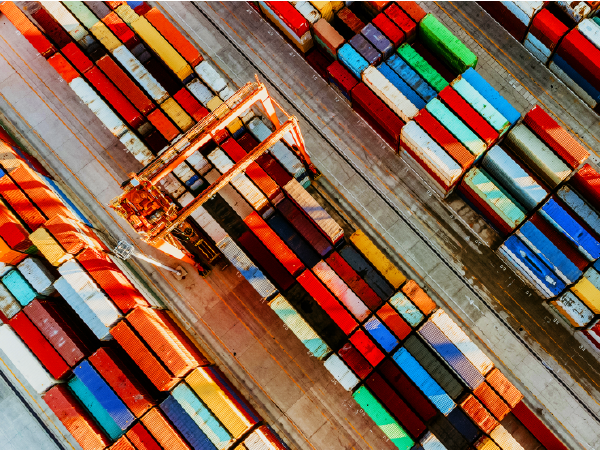Cotton trading is complex. Cotton merchants need to manage their inventories in granular detail down to the individual bale. Inventory management is a core competency for traders looking to reduce this complexity, but as we will see, effective inventory management has an impact far beyond simply improving logistics processes.
Read on as we explore how embedding inventory management in your CTRM improves cotton traceability, interactions with banks and other external stakeholders, internal communication, and even helps you get ahead of carbon reporting and sustainability legislation.
Physical location management
Unlike a traditional CTRM, inventory management is a core feature of CommOS, so you can bring your entire trading, operations, and risk functions together in one place.
Position and location management are the basics in inventory management; they allow you to see what you have, where it is, where it came from and where it’s going. This is done by creating “virtual lots” which are a digital representation of the physical goods as they transform through the supply chain. As HVI data is added, bales moved between lots, containers filled, and other actions completed, the virtual lot is updated to show the live real-world situation.
Much of the simplicity of managing physical inventories in CommOS comes from the automated workflows that manage approvals, data-sharing, document creation, and other activities. CommOS comes with several cotton-specific workflows ready to use straight away, and during implementations we show your team how to customise your workflows to your own unique processes.
These workflows vary greatly by origin, organisation, and the type of logistics operation; you may need multiple workflows based on whether there is HVI and quality data available as gin files or take-up data, whether pre-payment is required, whether a buyer is domestic or overseas, or if you’re shipping on consignment. Where a domestic buyer may need a warehouse release note, overseas sales may require an export packing order document together with container number and seal, as well as other shipping documents.
Read more about how CommOS helps cotton traders manage multiple complex workflows in international logistics.
Inventory management and traceability
Inventory management plays a key role in cotton traceability, which is a burning issue today off the back of COP26 pledges to end deforestation. Due diligence and provenance will no longer be optional; just consider the latest EU legislation carrying fines of 4% of total EU turnover for non-compliance. While cotton is not currently in the list of commodities covered by this particular law, it is demonstrative of how seriously traceability needs to be treated.
Managing all your activities in CommOS means you can trace stock across your operations, and from the end client back to the gin. And if you typically receive information on growers, you can include grower information fields in CommOS and trace bales right back to the farm.
CommOS allows your operators to manage the physical location of your stock with complete traceability across your operations. And because all your teams are working in the same connected system, traders and risk managers who need to understand physical positions have a live view as well.
On top of this, Gen10 help you integrate complementary apps and APIs such as live container tracking services, ERP and accounting, certification platforms and more into your CommOS ecosystem. So you know which bales are BCI certified, what their HVI and manual class is, when it’s going to arrive, where it’s come from and ultimately what its carbon emissions are.
Communicating externally
Just knowing which lots or bales are stored in each warehouse is only part of the challenge. There are a lot of stakeholders involved in the logistics of cotton inventory, including customers, banks, insurance providers, inspection service companies, shipping lines and freight forwarders.
This creates volumes of communication, documents and sharing of the same information for different purposes, but ultimately towards the same goal.
When it is time to ship stock, your team need to instruct the warehouse which goods to ship, and need to receive confirmation (or alternative information) from the warehouse. Banks need to authorise releases of stock they are financing. Insurance companies need stock and shipments declarations and exposure/capacity limits controlled to comply with your policy. Inspection companies need to receive instructions to supervise the stuffing and weighing of containers. Freight forwarders need to be instructed what to do with your cotton and where to take it.
All the above requires documentation, the sharing of data and involves really complex workflows and controls – which as discussed above can vary between origin, organisation and type of operation. The risk of errors is great and can lead to costly delays and missed opportunities. CommOS helps you process, communicate and keep track of all of this digitally and securely – saving a heap of time, reducing errors, and providing a full audit trail for verification, reporting and compliance.
Communicating internally
As mentioned above, with all your teams operating in the same system and CommOS updating in real-time based on the live situation, internal communication is easier than ever.
Traders can instantly check their live positions and see what is available/allocated, as well as whether contracts have had bales allocated to them. Additionally, the automated workflows can include notifications that ensure other teams are updated whenever is relevant for them based on inventory movement.
And as well as these live positions, anybody with the relevant permissions can create management reports and other summary reports whenever they need them. All using real-time live data and with no need to wait for any overnight or batch processes, or for colleagues to log activities that have taken place elsewhere.
Contract and invoice creation is also much easier with the internal data sharing that means that quality data does not need to be re-added once it has been uploaded to CommOS. And Gen10’s Formula.Engine automatically calculates pricing, premiums and discounts using this quality data, down to the bale HVI level where necessary.
Conclusion
Inventory management is complex and varied in the cotton industry. ESG compliance, traceability and Scope 3 carbon accounting are essential to today’s cotton merchants, some becoming mandatory with the prospect of heavy fines and costly damage to reputations.
Strong data and process management on a modern infrastructure are critical success factors to these ends. And connecting to other web services and systems is getting easier and more prevalent.
Traditional cotton systems have not kept pace with the needs of the industry. But this is exactly why and how Gen10’s CommOS has been designed. As well as ensuring operators have the information to do their jobs quickly and efficiently, CommOS automates many manual and time-consuming tasks, minimising errors and operational risks, communicating with other systems via web services wherever possible.
Bringing this communication, physical inventory management and traceability together with your trading, risk and compliance functions therefore benefits your organisation as a whole, not just your logistics or operations department.
And CommOS has many other benefits for cotton merchants too – find out about them now.
This article is part of a series exploring CTRM and Commodity Management in cotton trading.



